Tea ceremonies where you can enjoy a bowl of matcha with fine traditional sweets is a must-not-miss experience when visiting Japan. Not just in Kyoto, you can enjoy the graceful ceremony even in Tokyo teahouses. Learn the history, necessary tools, and steps of a sado below.
Table of Contents
- History of Japanese Tea Ceremonies
- Japanese Tea Ceremony Set - Bowl and Utensils
- Japanese Tea Ceremony Steps
- Experiencing Japanese Tea Ceremony
- Takeaway
Also called chanoyu 茶の湯 and sado / chado 茶道, Japanese tea ceremony is the ceremonial art of preparing matcha 抹茶 - powdered green tea. To offset its bitterness, matcha is usually enjoyed with wagashi 和菓子 - traditional Japanese sweets.
Sado is carried out in tatami-floored cha-shitsu 茶室 - tea rooms, and even the seating positions denoting the host and guests is important. Formal clothing is a must. Though in recent times, aside from the host, the guests may (with permission) wear Western formal wear. Some places that cater to tourists allow casual wear - this is not the norm.
For more about Matcha and Uji Matcha:
Uji Matcha: Treating Yourself to the Best
History of Japanese Tea Ceremonies
Tea was introduced to Japan sometime around the 8th century along with Buddhism. At that time, it was enjoyed in sencha 煎茶 form - dried tea leaves with hot water. It wasn’t until the Kamakura period when Zen Buddhist monks introduced the method of making matcha by grinding tea leaves into powder. The higher caffeine content in powdered tea leaves allowed the monks to stay awake and meditate. The traditional culture of tea ceremonies including the necessary utensils and procedure gradually developed over time.
※ Encyclopaedia Brittanica, “tea ceremony”
Sen Rikyu and Tea Ceremony Schools
The ancestor of tea, Sen Rikyu 千利休, is responsible for the tea ceremony’s philosophy of wabi-cha わび茶 - wabisabi (beauty in simplicity) + tea. Of the many schools of tea ceremony in Japan, most if not all of them have their teachings derived from this philosophy.
There are 3 main tea schools descended from Sen Rikyu - Omotesenke 表千家, Urasenke 裏千家, Mushakoujisenke 武者小路千家. Together, they are known as the Sansenke 三千家 - Three Sen Families.
Writer's Pick
Japanese Tea Ceremony Set - Bowl and Utensils
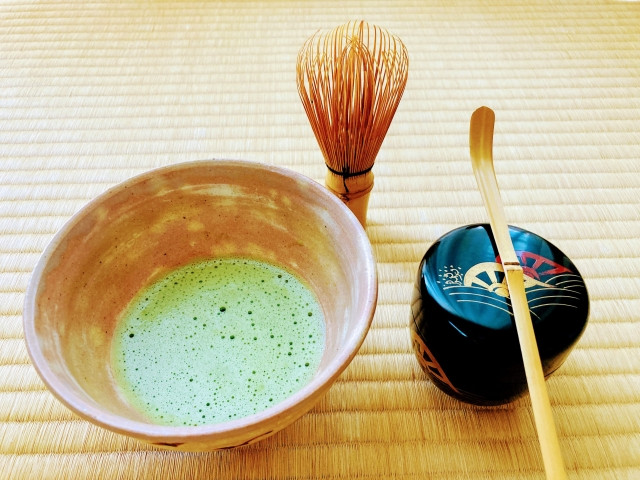
These are the three essential tools to perform a tea ceremony:
Cha-wan 茶碗 - Bowl to prepare matcha; comes in many materials and patterns
Cha-sen 茶筅 - Bamboo whisk for mixing matcha; be careful not to break
Cha-shaku 茶杓 - Scoop for the optimum amount of matcha powder; typically bamboo
These are not essential but teahouse hosts will have them as not only to keep up the tradition but to create the important atmosphere and maintain the elegance of the ceremony:
Chakin 茶巾: Cloth to wipe the bowl after guest has drunk matcha
Fukusa 袱紗 - Silk cloth to clean the tea scoop, tea caddy, and handle the kettle; used by the host
Natsume 棗 - Lacquered tea caddy for thin tea powder
Chaire 茶入 - Ceramic tea caddy for strong tea powder

Hishaku 柄杓 - Bamboo casotte to draw and pour water; there are three types
Cha-gama 茶釜 - Iron kettle to boil water
For a souvenir or a special gift, you can get for a reasonable price the most basic of tea ceremony sets containing only the bowl, tea whisk, and tea scoop. The matcha may come with the set.
Japanese Tea Ceremony Steps
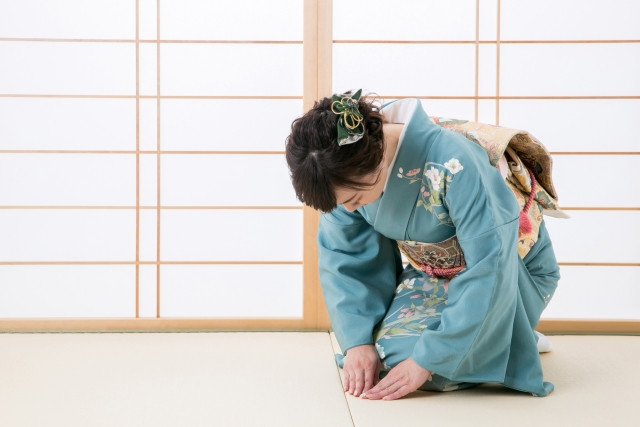
1. Preparation
Put on your kimono and remove all accessories including rings, watch, long necklaces,etc. that may come in contact with the bowl and potentially damage it. For those with long hair, keep it tied up neatly without gaudy accessories. No strong perfumes that will distract yourself and other guests from the experience. Optional but would be polite to bring a spare pair of white socks to change into when entering the tea room.
2. Entering the Tea Room
Do not step on the borders of the tatami. If the door isn’t already open, sit before it and slide it open. If it is open, bow and enter. Sit seiza-style on the tatami floor.
3. Greetings
Once everybody is seated, greet the host by bowing. You may say “Yoroshiku onegaishimasu” if you want but bowing is sufficient.
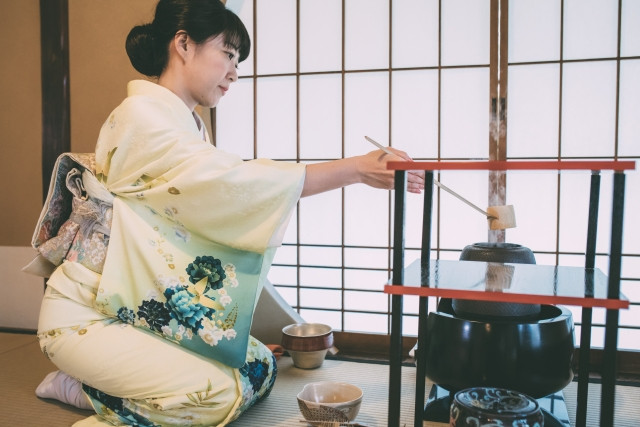
4. Watch the Tea Preparation
The host will prepare the tea in front of you. Just quietly watch and admire the grace in their movements. The host may also explain the process to you.
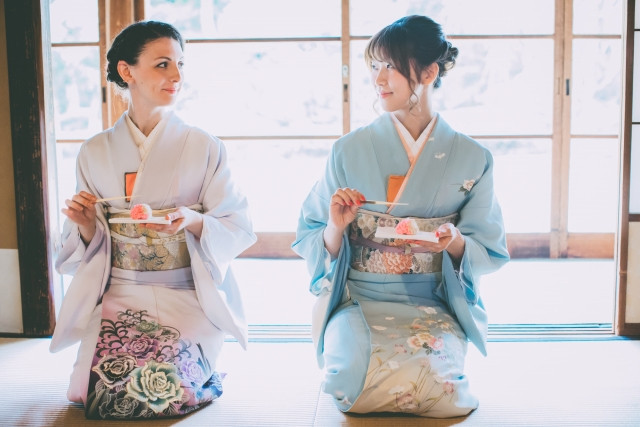
5. Eating the Sweets
A small piece of Wagashi is served before the tea. If there are many people, the sweets container will be passed down the line so take only your share and pass it along. Do not eat the sweet in one whole bite. Using both hands; 1 hand holding the sweet on its paper and the other hand using the provided utensil (chopsticks/sweet-cutter), savour it slowly.
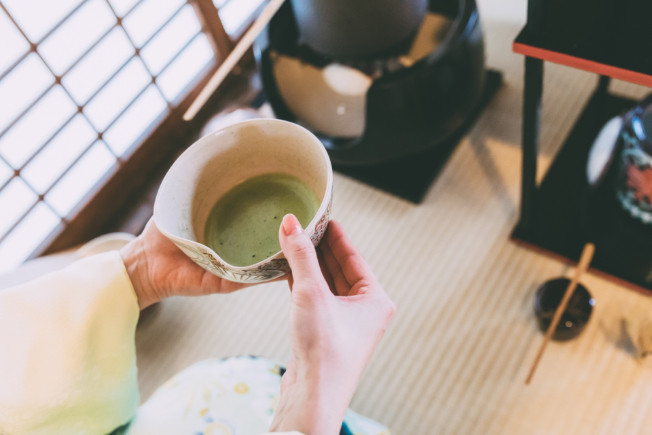
6. Drinking the Tea
The tea will be served after sweets. The bowl will be placed in front of you. The bowl’s front will be facing you. Pick it up with your right hand and bring it to your left palm which will support its base. The bowl will be held in both hands now. Rotate the bowl 90° so that the front is now facing forward - same direction you are facing. Drink from the bowl until the last drop including the froth. There’s no rule on this but 3 sips is the average to finish. Place the bowl back on the tatami when you’re done.
7. Ending
There will be time for guests to admire the bowl and the room’s decorations before the ceremony ends. When handling the bowl, do not raise it high but leave it on the tatami mat to admire it - the bowls can be super expensive so you don’t want to risk breaking them. You may be asked whether you want some more tea; if nobody does then the ceremony ends. Give your thanks - “Arigatou gozaimasu” to the host.
Experiencing Japanese Tea Ceremony
Now that you know how tea ceremonies work, I’m sure you’re itching to give it a go. Kyoto has a large number of teahouses you can experience a tea ceremony at but you needn’t go that far as Tokyo has some too. Here are some places in Tokyo to visit:
Maikoya in Shinjuku
Maikyo is the leading foreigner-friendly geisha and tea ceremony experience in Kyoto’s Gion district. They also have branches in Tokyo and Osaka. The Tokyo branch, though not offering geisha experiences, is popular for their tea ceremonies. They have both kimono-wearing and casual clothes tea ceremonies.
Waraku-an in Meguro
Only 2 train stops away from Shibuya Station, you can find Waraku-an by following their easy to follow directions at their website. The great thing about this place is that they provide free guidance for first-timers teaching everything from manners, how to drink, and how to sit. If you’re not confident with your Japanese, they offer English, Mandarin, and Korean interpretation for a fee but you’ll need to book at least 4 weeks in advance.
Chazen in Ginza and Asakusa
Established by tea master Rie Takeda who performs tea ceremonies all over the world. Aside from traditional tea ceremonies, they also offer other types of experiences like making your own matcha and grinding your own powder.
Shizu-Kokoro in Asakusa
Shizu-Kokoro offers a tea ceremony workshop in English where you can learn all the basics of chado from enjoying the ceremony as a guest to hands-on experience of being the host making the tea. For only 4,180 yen (that’s a steal), the experience includes wagashi and different teas to try.
Takeaway
Embedded deep in Japanese culture and tradition, Japanese tea ceremonies are a one-of-a-kind experience you can enjoy in Japan. Aside from these standalone teahouses we introduced, it is also possible to experience tea ceremonies at temples. One of the best experiences is enjoying a tea ceremony whilst admiring a traditional Japanese garden.
Read all about Japanese gardens here: The Captivating Gardens of Japan


































